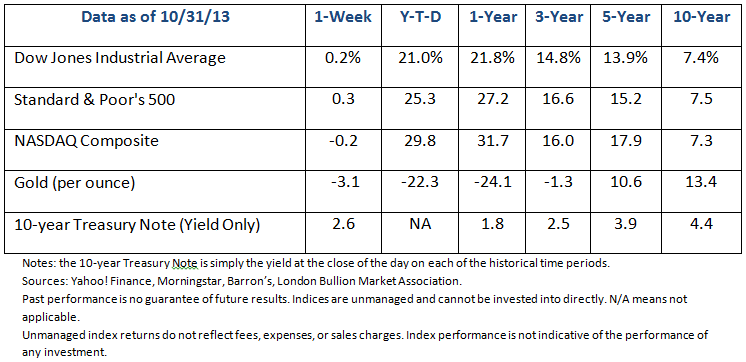You can always learn from a bad example.
If you’ve ever heard me discuss my philosophy on investing, you know that I believe in the institutional process. I even committed to it in Chapter Two of my book, Make Your Money Last a Lifetime™. One institution, the New York City Opera, abandoned the process with disastrous results. According to news reports, the Opera is likely to close its doors permanently after some serious missteps with its endowment. The endowment balance in 2001 was $51.6 million. The balance in 2013? $5.2 million. Founded in 1943, the Opera has now ceased operations. What a shame.
What did they do wrong? And more important, how can you avoid making the same mistake with your own investments?
A quick recap of the institutional model. Institutions, such as endowments, draft an Investment Policy Statement (IPS). The IPS dictates how the money is to be invested. For example, it might direct that a certain percentage always be in stocks, bonds and cash. As trustees, those operating the endowment must follow the IPS or be liable. Investment Policy Statements are designed to help the institution follow a disciplined investment strategy in an effort to avoid chasing the market on the way up or selling in a panic on the way down.
The New York City Opera appears to have not followed this basic practice. According to a New York Times article dated October 11, 2013, “In what appears to have been panic selling, the City Opera board sold all the equities in the opera’s endowment and moved to cash in October 2008, as the stock market was plunging to new lows, and stayed in cash during 2009, as the market recovered and surged upward.”
Mistake number one: panicking in difficult market conditions. The board of trustees went against the institutional process and paid the ultimate price.
Mistake number two: The same article reveals that the City Opera board raided the endowment to pay bills.
As individuals we call that, “living beyond your means.” Spend more than you can afford and having tens of millions in the bank won’t save you.
Do you have a disciplined strategy? Can you outline it in just a few words? Do you have a budget and know how much you can afford to spend?
In this case, their experience isn’t entirely worthless…it can serve us as a bad example. I suggest that you do the opposite of the New York City Opera. Have an investment philosophy and discipline that makes sense, stick with it and spend less than you can afford. While there are no guarantees, this is a really good start, and that’s music to anyone’s ears.
Falling unemployment means more people are employed. Or does it?
In the most recent release of payroll data, unemployment fell from 7.3% to 7.2%. Continued decreases in unemployment sound promising right? While we are clearly approaching the Fed’s target of 6.5% unemployment (down from nearly 10% in January 2010), these numbers are not as wonderful as they seem.
The issue lies in the definition of unemployment. Unemployment is defined as the number of individuals currently unemployed divided by the “workforce.” “Workforce” is the sum of employed individuals and currently unemployed individuals. This definition is well-rooted in classical economics and is most likely the best measure of unemployment. However, it creates one interesting issue. The unemployment rate is determined by taking the number of unemployed seeking work, then dividing that by the total work force.
Here’s where it gets sticky. If less people are seeking work, it appears as if the unemployment numbers are getting better, when really what is happening is that less people are seeking work. They’ve dropped out of the work force completely. It’s a ‘false positive’ if you will.
September payroll data reflected an increase in the labor force of 73,000 people, significantly fewer than in prior years. While it is difficult to be certain, it seems many unemployed individuals have ceased the job search, thereby decreasing the unemployment rate. This fact potentially skews the employment data, clouding the true colors of the economic recovery since 2008.
Although decreasing unemployment rates is something to celebrate, we must be skeptical and even a bit concerned that many of these unemployed individuals are just dropping out of the labor force, inflating the economic improvement the Fed is so desperately watching.
The Markets

This newsletter was prepared by Bourke Wealth Management.
P.S. Please feel free to forward this commentary to family, friends, or colleagues. If you would like us to add them to the list, please reply to this e-mail with their e-mail address and we will ask for their permission to be added.
The Standard & Poor’s 500 (S&P 500) is an unmanaged group of securities considered to be representative of the stock market in general.
The 10-year Treasury Note represents debt owed by the United States Treasury to the public. Since the U.S. Government is seen as a risk-free borrower, investors use the 10-year Treasury Note as a benchmark for the long-term bond market.
Gold represents the London afternoon gold price fix as reported by the London Bullion Market Association.
Yahoo! Finance is the source for any reference to the performance of an index between two specific periods.
Opinions expressed are subject to change without notice and are not intended as investment advice or to predict future performance.
Past performance does not guarantee future results.
You cannot invest directly in an index.
Consult your financial professional before making any investment decision.
The opinions voiced in this material are for general information only and are not intended to provide specific advice or recommendations for any individual. To determine which investment(s) may be appropriate for you, consult your financial advisor prior to investing.
Sources:
Barron’s (http://online.barrons.com/home-page)
Bloomberg (https://www.bloomberg.com/)
London Bullion Market Association (https://www.lbma.org.uk/)
Morningstar (http://www.morningstar.com/)
Horsesmouth (http://www.horsesmouth.com/ )
Wall Street Journal (http://online.wsj.com/home-page?mg=inert-wsj)
Yahoo! Finance (http://finance.yahoo.com/)


